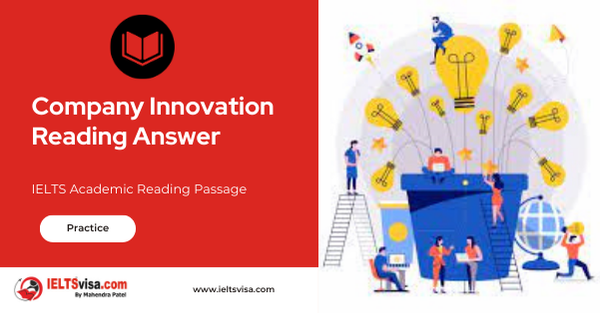Company Innovation Reading Answer
IELTS Academic Reading Passage
PASSAGE

Company Innovation
A
In a scruffy office in midtown Manhattan, a team of 30 artificial-intelligence programmers is trying to simulate the brains of an eminent sexologist, a wellknown dietician, a celebrity fitness trainer and several other experts. Umagic Systems is a young firm, setting up websites that will allow clients to consult the virtual versions of these personalities. Subscribers will feed in details about themselves and their goals; Umagic’s software will come up with the advice that the star expert would give. Although few people have lost money betting on the neuroses of the American consumer, Umagic’s prospects are hard to gauge (in ten years’ time, consulting a computer about your sex life might seem natural, or it might seem absurd). But the company and others like it are beginning to spook large American firms, because they see such half-barmy “innovative” ideas as the key to their own future success.
B
Innovation has become the buzz-word of American management. Firms have found that most of the things that can be outsourced or re-engineered have been (worryingly, by their competitors as well). The stars of American business tend today to be innovators such as Dell, Amazon and Wal-Mart, which have produced ideas or products that have changed their industries.

Company Innovation
C
A new book by two consultants from Arthur D. Little records that, over the past 15 years, the top 20% of firms in an annual innovation poll by Fortune magazine have achieved double the shareholder returns of their peers. Much of today’s merger boom is driven by a desperate search for new ideas. So is the fortune now spent on licensing and buying others’ intellectual property. According to the Pasadena-based Patent & Licence Exchange, trading in intangible assets in the United States has risen from $15 billion in 1990 to $100 billion in 1998, with an increasing proportion of the rewards going to small firms and individuals.
D
And therein lies the terror for big companies: that innovation seems to work best outside them. Several big established “ideas factories”, including 3M, Procter & Gamble and Rubbermaid, have had dry spells recently. Gillette spent ten years and $1 billion developing its new Mach 3 razor; it took a British supermarket only a year or so to produce a reasonable imitation. “In the management of creativity, size is your enemy,” argues Peter Chemin, who runs the Fox TV and film empire for News Corporation. One person managing 20 movies is never going to be as involved as one doing five movies. He has thus tried to break down the studio into smaller units—even at the risk of incurring higher costs.

Company Innovation
E
It is easier for ideas to thrive outside big firms these days. In the past, if a clever scientist had an idea he wanted to commercialise, he would take it first to a big company. Now, with plenty of cheap venture capital, he is more likely to set up on his own. Umagic has already raised $5m and is about to raise $25m more. Even in capital-intensive businesses such as pharmaceuticals, entrepreneurs can conduct early-stage research, selling out to the big firms when they reach expensive, risky clinical trials. Around a third of drug firms’ total revenue now comes from licensed-in technology.
F
Some giants, including General Electric and Cisco, have been remarkably successful at snapping up and integrating scores of small companies. But many others — T ^ worry about the prices they have to pay and the difficulty in hanging on to the talent that dreamt up the idea. Everybody would like to develop more ideas in-house. Procter & Gamble is now shifting its entire business focus from countries to products; one aim is to get innovations accepted across the company. Elsewhere, the search for innovation has led to a craze for “intrapreneurship”—devolving power and setting up internal ideas-factories and tracking stocks so that talented staff will not leave.
G
Some people think that such restructuring is not enough. In a new book Clayton Christensen argues that many things which established firms do well, such as looking after their current customers, can hinder the sort of innovative behaviour needed to deal with disruptive technologies. Hence the fashion for cannibalisation—setting up businesses that will actually fight your existing ones. Bank One, for instance, has established Wingspan, an Internet bank that competes with its real branches (see article). Jack Welch’s Internet initiative at General Electric is called “Destroyyourbusiness.com”.
H
Nobody could doubt that innovation matters. But need large firms be quite so pessimistic? A recent survey of the top 50 innovations in America, by Industry Week, a journal, suggested that ideas are as likely to come from big firms as from small ones. Another skeptical note is sounded by Amar Bhidé, a colleague of Mr Christensen’s at the Harvard Business School and the author of another book on entrepreneurship. Rather than having to reinvent themselves, big companies, he believes, should concentrate on projects with high costs and low uncertainty, leaving those with low costs and high uncertainty to small entrepreneurs. As ideas mature and the risks and rewards become more quantifiable, big companies can adopt them.
I
At Kimberly-Clark, Mr Sanders had to discredit the view that jobs working on new products were for “those who couldn’t hack it in the real business.” He has tried to change the culture not just by preaching fuzzy concepts but also by introducing hard incentives, such as increasing the rewards for those who come up with successful new ideas and, particularly, not punishing those whose experiments fail. The genesis of one of the firm’s current hits, Depend, a more dignified incontinence garment, lay in a previous miss, Kotex Personals, a form of disposable underwear for menstruating women.
J
Will all this creative destruction, cannibalisation and culture tweaking make big firms more creative? David Post, the founder of Umagic, is sceptical: “The only successful intrapreneurs are ones who leave and become entrepreneurs.” He also recalls with glee the looks of total incomprehension when he tried to hawk his “virtual experts” idea three years ago to the idea labs of firms such as IBM though, as he cheerfully adds, “of course, they could have been right.” Innovation unlike, apparently, sex, parenting and fitness is one area where a computer cannot tell you what to do.
Questions 28-33
The reading Passage has ten paragraphs A-J.
Which paragraph contains the following information?
Write the correct letter A-J, in boxes 28-33 on your answer sheet
NB You may use any letter more than once.
28. Approach to retain best employees
29. Safeguarding expenses on innovative idea
30. Integrating outside firms might produce certain counter effect
31. Example of three famous American companies’ innovation
32. Example of one company changing its focus
33. Example of a company resolving financial difficulties itself
Questions 34-37
Do the following statements agree with the information given in Reading Passage?
In boxes 34-37 on your answer sheet, write
TRUE if the statement is true
FALSE if the statement is false
NOT GIVEN if the information is not given in the passage
34. Umagic is the most successful innovative company in this new field.
35. Amazon and Wal-Mart exchanged their innovation experience.
36. New idea holder had already been known to take it to small company in the past.
37. IBM failed to understand Umagic’s proposal of one new idea.
Questions 38-40
Choose the correct letter, A, B, C or D.
Write your answers in boxes 38-40 on your answer sheet.
38 What is author’s opinion on the effect of innovation in paragraph C?
A. It only works for big companies
B. Fortune magazine has huge influence globally
C. It is getting more important
D. Effect on American companies is more evident
39 What is Peter Chemin’s point of view on innovation?
A. Small company is more innovative than big one
B. Film industry need more innovation than other industries
C. We need to cut the cost when risks occur
D. New ideas are more likely going to big companies
40 What is author’s opinion on innovation at the end of this passage?
A. Umagic success lies on the accidental “virtual experts”
B. Innovation is easy and straightforward
C. IBM sets a good example on innovation
D. The author’s attitude is uncertain on innovation

Solutions For:-Company Innovation Reading Answer
| 28. F | 32. F | 36. False | 40. D |
| 29. C | 33. E | 37. True | |
| 30. G | 34. Not Given | 38. C | |
| 31. B | 35. Not Given | 39. A |
Review and Practice
- Regularly practice with IELTS reading samples and time yourself to get used to the pressure of the exam.
- Review your mistakes to understand where you went wrong and how to avoid similar errors in the future.
Our Books
Master IELTS Speaking Part 1
IELTS Writing Task 1 Book
IELTS Writing Task 2 Book
Company Innovation Reading Answer Explanation
Comin Soon
Practice IELTS Other Modules
IELTS Listening
The IELTS Listening test assesses how well you can understand spoken English in various contexts. It lasts about 30 minutes and is divided into four sections with a total of 40 questions. The listening tasks become increasingly difficult as the test progresses.
IELTS Academic Reading
The IELTS Academic Reading section assesses your ability to understand and interpret a variety of texts in academic settings. It is designed to evaluate a range of reading skills, including skimming for gist, reading for main ideas, reading for detail, understanding inferences, and recognizing a writer's opinions and arguments.
IELTS Speaking
The IELTS Speaking test assesses your ability to communicate in English on everyday topics. It lasts 11-14 minutes and consists of three parts: introduction, cue card, and a discussion based on the cue card topic.
IELTS General Reading
IELTS General Reading tests your ability to understand and interpret various types of texts. Here are some key areas and types of content you can expect to encounter in the reading section, along with tips for effective preparation.
IELTS Academic Writing Task 1
In IELTS Academic Writing Task 1, you are presented with a visual representation of information, such as graphs, charts, tables, or diagrams, and you are required to summarize, compare, or explain the data in your own words.
IELTS General Writing Task 1
In IELTS General Writing Task 1, you are required to write a letter based on a given situation. The letter can be formal, semi-formal, or informal, depending on the prompt. Here’s a breakdown of the key components to include in your letter
IELTS Academic Writing Task 2
In IELTS Academic Writing Task 2, you are required to write an essay in response to a question or topic. Here’s a guide to help you understand the essential elements of this task
IELTS Exam Tips
To succeed in the IELTS exam, practice regularly, familiarize yourself with the test format, improve your vocabulary, develop time management skills, and take mock tests to build confidence.
Grammer for IELTS
Grammar is the foundation of effective communication in English. Understanding tense usage, subject-verb agreement, and sentence structure enhances clarity and coherence in writing and speaking.
Vocabulary for IELTS
Vocabulary plays a crucial role in the IELTS (International English Language Testing System) exam, especially in the Speaking and Writing sections. Here’s an overview of why vocabulary is important and how it impacts your performance
RECENT IELTS SAMPLES QUESTIONS AND ANSWERS
Clicks, Bricks, and Bargains
A. It's a new phenomenon called "Cyber Monday". On November 28th millions of Americans...
Are You Experienced?
How we spend our money is changing. In the new “experience economy”, we pay to do things, not...
A Meat-Eater’s Counter
You might be forgiven sometimes for thinking that vegetarians are somehow superior human...
An Earth-Shaking Discovery
In 1963, a paper appeared in the journal Nature that radically changed the way we view this...
Working in the movies
When people ask French translator Virginie Verdier what she does for a living, it must be...
AC or DC: The War of Currents
Electricity can be delivered in either alternating current (AC), or direct current (DC), and...













